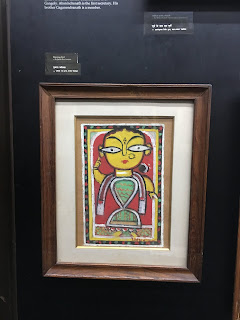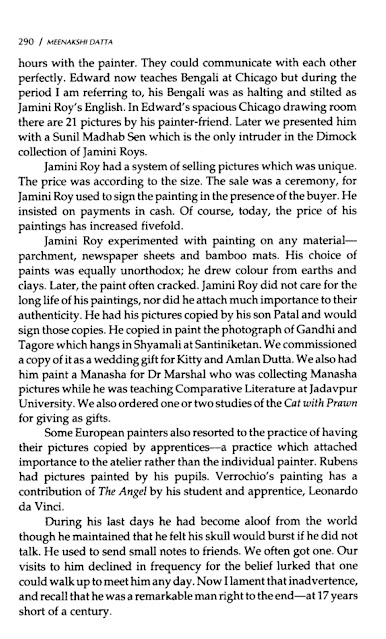If you have grown up in Calcutta (I dare say Bengal), chances are you would have seen Jamini Roy’s influence in everyday Bengali pop culture. Even if you don’t know his name (which is unlikely), you would definitely know his iconic style of art. For example, this was a random photograph (below) I clicked on a park wall when I had gone to get my photo clicked for my Aadhaar card. Just a random decoration and yet it proved that Jamini Roy achieved what he set out to do. According to the National Galleries of Scotland website, “Roy’s intention was to make art which was affordable to everyone and to replace the idea of an artist having solo creative power. This was an aim also shared by Western artists such as Andy Warhol.”. Beautiful, isn’t it?
Feluda fans (like me) will also remember the painting in Feluda’s drawing room. For the drawing room scene in Sonar Kella, Ray wanted a genuine Jamini Roy painting to be put up on the wall. When he couldn't find one on time, he painted this himself.
His style of art is ubiquitous in the many street shops of Gariahat selling art prints, terracotta curios and other knickknacks. The only time I think I have actually seen an original work by Jamini Roy, is December 2018 at the Victoria Memorial galleries in Calcutta. It was this artwork below titled “Dancing Girl”:
Here’s a bit more about the great artist: Jamini Roy (1887-1972) is often regarded as the father of modern art in India; his work is unequivocally Indian and modern. An iconic artist with a signature style and one of the most famous pupils of Abanindranath Tagore, Jamini Roy is internationally recognised for his endeavours in the world of Bengali folk paintings, that ushered in a new beginning in the history of Indian modern art. Artists today are still inspired by him and copy his techniques. Sample this:
His drawing on the popular and folk traditions of rural Bengal for his inspiration. Born in Beliatore, West Bengal, Roy studied at the Calcutta College of Art. His paintings can be divided into three main themes: the everyday life of rural Bengal, particularly the women of the aboriginal Santhal community, Hindu mythological subjects and Christian imagery.
His early works were in a western, academic style, and he was particularly influenced by Post Impressionism. However, from 1925, Roy turned to traditional Bengali art for inspiration, adopting the style of folk painters or ‘patuas’ who illustrated gods and legends. His later work also features Christian themes (I was surprised to see his version of the Last Supper - see below)
Jamini Roy developed his signature style which was characterised by bold lines and flat use of colour. He replaced costly canvas and oil paints with indigenous pigments and other inexpensive materials and mediums. He used indigenous materials, including lamp black for the outline drawing, 7 basic colours (Indian red, yellow ochre, cadmium green, vermilion, grey, blue and white), which he applied with organic tempera, earth and mineral pigments to homemade canvas spun with fabric.
Again, other artists and I have tried copying but only when you try and mimic his style, you realise how difficult it is to draw clean bold black lines and use a limited palette of colours to convey a story, an emotion in such a captivating manner. Here are some of my personal favourites:
—
Sources:
https://collections.vam.ac.uk/item/O134001/the-last-supper-painting-jamini-roy/
https://www.nationalgalleries.org/art-and-artists/artists/jamini-roy
https://artist.christies.com/Jamini-Roy-42388-bio.aspx
https://www.artisera.com/collections/jamini-roy
https://www.britishmuseum.org/collection/term/BIOG181748




















